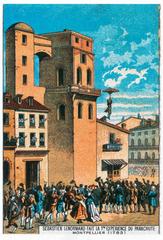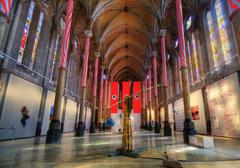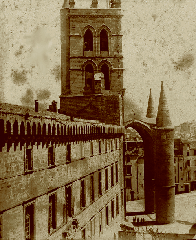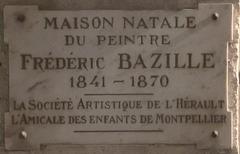
Comprehensive Guide to Visiting La Tour de la Babote, Montpellier, France
Date: 31/07/2024
Introduction
Nestled in the heart of Montpellier, France, La Tour de la Babote stands as a testament to the city’s rich historical and architectural heritage. This iconic structure, which dates back to the 12th century, has evolved from a medieval fortification into a center for astronomical research and a symbol of Montpellier’s resilience. Initially part of the city’s defensive network, the tower’s strategic importance is underscored by its robust construction and vantage point, which provided a critical lookout against invasions (Montpellier Tourism). Over the centuries, La Tour de la Babote has undergone significant transformations, including its conversion into an observatory in the 18th century and its role in telegraphy in the 19th century (Montpellier France). Today, it continues to captivate visitors with its panoramic views, rich history, and cultural significance, making it a must-visit destination for anyone exploring Montpellier. This comprehensive guide will provide you with all the essential information, from historical insights and architectural details to practical tips for visitors, ensuring you have a memorable and well-informed visit.
Table of Contents
- Introduction
- Historical Background
- Visitor Experience
- Nearby Attractions and Travel Tips
- Frequently Asked Questions (FAQ)
- Conclusion
Historical Background
Origins and Medieval Significance
The Tour de la Babote, a prominent historical landmark in Montpellier, France, traces its origins back to the 12th century. Initially constructed as part of the city’s fortifications, the tower was a crucial element in the defensive network designed to protect Montpellier from invasions. The fortifications, known as the “Commune Clôture,” encircled the historical center of Montpellier, known as L’Ecusson. The tower’s strategic location and robust construction made it an essential watchtower, providing a vantage point for guards to monitor and defend against approaching enemies (Montpellier Tourism).
Architectural Features
The Tour de la Babote is characterized by its cylindrical shape, crenelated battlements, and arrow slits, which are indicative of the advanced defensive techniques of the medieval period. These architectural features not only enhanced the tower’s defensive capabilities but also contributed to its imposing presence. The crenelated battlements allowed defenders to launch projectiles while remaining protected, and the arrow slits provided narrow openings for archers to shoot at attackers while minimizing their exposure (InFrance).
Transformation into an Observatory
In the 18th century, the Tour de la Babote underwent a significant transformation. In 1740, the States of Languedoc approved the construction of an observatory on the foundations of the tower. By 1745, the tower had been converted into an observatory, and the Académie des Sciences took possession of it. This marked a new chapter in the tower’s history, as it transitioned from a military structure to a center for scientific observation. The observatory played a vital role in advancing astronomical research and was later taken over by the Société Royale des Sciences (Montpellier France).
Role in Telegraphy
The 19th century saw another shift in the tower’s function. In 1832, the Tour de la Babote was repurposed for telegraphic services. This adaptation highlights the tower’s versatility and its ability to serve various technological advancements over the centuries. The telegraph department utilized the tower’s height and strategic location to facilitate communication, further cementing its importance in Montpellier’s history (InFrance).
Preservation and Restoration
Over the centuries, the Tour de la Babote has undergone meticulous restoration efforts to preserve its historical integrity. These efforts have ensured that the tower remains a symbol of Montpellier’s resilience and a tangible link to its storied past. The tower was officially listed as a historical monument in 1927, recognizing its cultural and historical significance. The preservation work has focused on maintaining the tower’s original architectural features while making it accessible to modern visitors (Montpellier Tourism).
Modern-Day Use and Cultural Significance
Today, the Tour de la Babote is occupied by the Fédération d’Astronomie Populaire Amateur du Midi (South of France Amateur Astronomy Federation). This modern use of the tower continues its legacy as a center for astronomical observation and education. The tower also serves as a popular tourist attraction, offering panoramic views of Montpellier and its surroundings. Visitors can ascend the spiral staircase to the viewing platform, where they are greeted by breathtaking vistas of the city’s historic center, the verdant countryside, and the Mediterranean Sea (Montpellier France).
Legends and Folklore
The Tour de la Babote is steeped in local legends and folklore, adding to its allure and mystique. One captivating tale revolves around its peculiar name. Legend has it that the tower was once inhabited by a beautiful young woman named Babotte. Known for her kindness and generosity, Babotte would often climb to the top of the tower to survey the surrounding countryside and watch over the people of Montpellier. Her presence became so synonymous with the tower that it eventually became known as the Tour de la Babote, a testament to her enduring legacy (InFrance).
Another intriguing legend speaks of a hidden treasure buried beneath the tower. According to local lore, a wealthy merchant, seeking to protect his vast riches during times of turmoil, concealed his fortune in a secret vault within the tower’s foundations. Despite numerous attempts to locate the treasure, it remains undiscovered, fueling the imaginations of treasure hunters and adventurers alike (InFrance).
Educational and Cultural Impact
The Tour de la Babotte continues to play an educational role in the community. Schools often organize visits to the tower to complement lessons in history and science. Students leave inspired by the stories of the guards and astronomers who once populated the tower. For tourists, the tower offers an immersive experience into the local culture and history of Montpellier. Each visit becomes a living chapter in the grand narrative of the city (GuideVilles).
Visitor Experience
Visiting the Tour de la Babote is a budget-friendly experience, with admission fees set at a reasonable rate. Discounts are available for students, seniors, and families, making it an affordable attraction for all. The tower’s operating hours vary depending on the season, with extended hours during the peak tourist season. Advance booking is recommended to avoid queues, especially during the summer months. Online ticketing options are available for convenience, allowing visitors to secure their tickets in advance and skip the line (InFrance).
Nearby Attractions and Travel Tips
When planning your visit to the Tour de la Babote, consider exploring nearby attractions such as the Place de la Comédie, the Musée Fabre, and the Montpellier Cathedral. These sites offer a deeper dive into the rich cultural fabric of Montpellier. For those traveling by public transport, the tower is accessible via several bus and tram lines. Additionally, there are numerous cafes and restaurants nearby where visitors can enjoy local cuisine.
Frequently Asked Questions (FAQ)
What are the Tour de la Babotte visiting hours?
The visiting hours vary by season. During the peak tourist season, the tower generally has extended hours. It is best to check the official website or contact the venue directly for the most up-to-date information.
How much are tickets for the Tour de la Babotte?
Ticket prices are reasonable, with discounts available for students, seniors, and families. Online ticketing options are also available for convenience.
Are guided tours available at the Tour de la Babotte?
Yes, guided tours are available and provide a comprehensive overview of the tower’s history and significance. It is recommended to book these tours in advance.
Is the Tour de la Babotte accessible for visitors with disabilities?
The tower has made efforts to improve accessibility, but due to its historical structure, certain areas may still pose challenges for visitors with disabilities. It is advisable to contact the venue for specific accessibility information.
Conclusion
La Tour de la Babote is not just a historical monument but a living museum that encapsulates the rich tapestry of Montpellier’s past and present. From its medieval origins as a defensive tower to its transformation into a center for astronomical observation and communication, the tower has continually adapted to the needs of the times. Today, it stands as a symbol of Montpellier’s architectural evolution and cultural heritage. Visitors to La Tour de la Babote can immerse themselves in its storied past through guided tours, educational programs, and panoramic views of the city. Whether you’re a history enthusiast, a photography buff, or simply looking to explore one of Montpellier’s most iconic landmarks, La Tour de la Babote offers a unique and enriching experience. For more information and updates on visiting hours, ticket prices, and guided tours, be sure to check the official websites linked in this guide. Don’t forget to explore nearby attractions like the Place de la Comédie and the Musée Fabre to complete your visit to this vibrant city (Montpellier France).
References
- Montpellier Tourism. (n.d.). Retrieved from Montpellier Tourism
- Montpellier France. (n.d.). Retrieved from Montpellier France
- Montpellier France. (n.d.). Retrieved from Montpellier France
- InFrance. (n.d.). Retrieved from InFrance
- GuideVilles. (n.d.). Retrieved from GuideVilles









